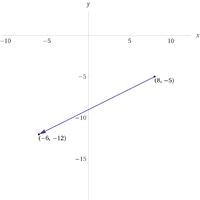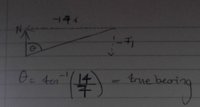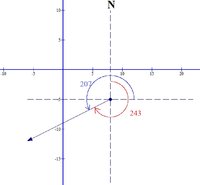Q is such A guard at O monitors the movement of a boat.
At 10:00 the boat is (8i-5j) km relative to O
At 12:50 the boat is at the point (-6i-12j) km relative to O
The motion of the boat is modelled as a particle moving at a constant speed on a straight line.
(a) Calculate the bearing on which the boat is moving.
For question (a), I 1. calculated the difference in position vectors 1. -6-8 i + -12+5 j = -14i -7j
I then calculated tan-1(14/7) = 64.434... deg
would this be correct? I am aware that this is not the velocity vector and that I would have to divide both magnitudes by the time elapsed between the two position vectors, that is 2 hr:50 mins = (17/6) hr = 2 .833333... hr
but surely it is just a scale factor so my answer angle would be the same?
(b) calculate the speed of the boat giving your answer in km hr-1
Finding the velocity vector
-(14/2.83333) i - (7/2.83333) j
2. I square root [ (14/2.83333)2+ (7/2.83333)2 ]
Are my workings and method correct?
Thank you,
At 10:00 the boat is (8i-5j) km relative to O
At 12:50 the boat is at the point (-6i-12j) km relative to O
The motion of the boat is modelled as a particle moving at a constant speed on a straight line.
(a) Calculate the bearing on which the boat is moving.
For question (a), I 1. calculated the difference in position vectors 1. -6-8 i + -12+5 j = -14i -7j
I then calculated tan-1(14/7) = 64.434... deg
would this be correct? I am aware that this is not the velocity vector and that I would have to divide both magnitudes by the time elapsed between the two position vectors, that is 2 hr:50 mins = (17/6) hr = 2 .833333... hr
but surely it is just a scale factor so my answer angle would be the same?
(b) calculate the speed of the boat giving your answer in km hr-1
Finding the velocity vector
-(14/2.83333) i - (7/2.83333) j
2. I square root [ (14/2.83333)2+ (7/2.83333)2 ]
Are my workings and method correct?
Thank you,



